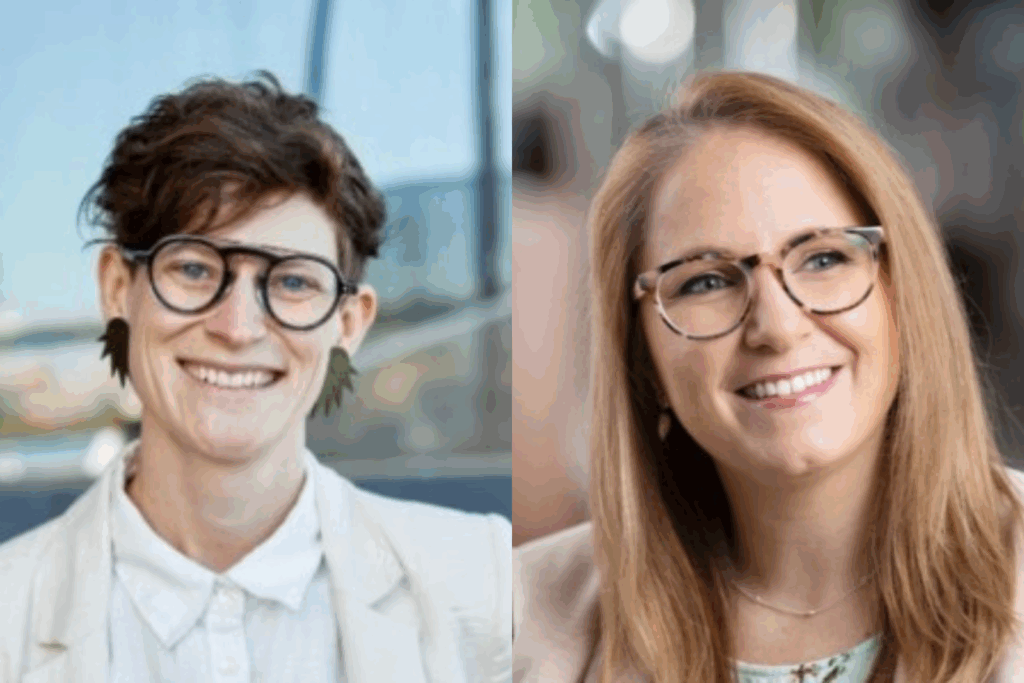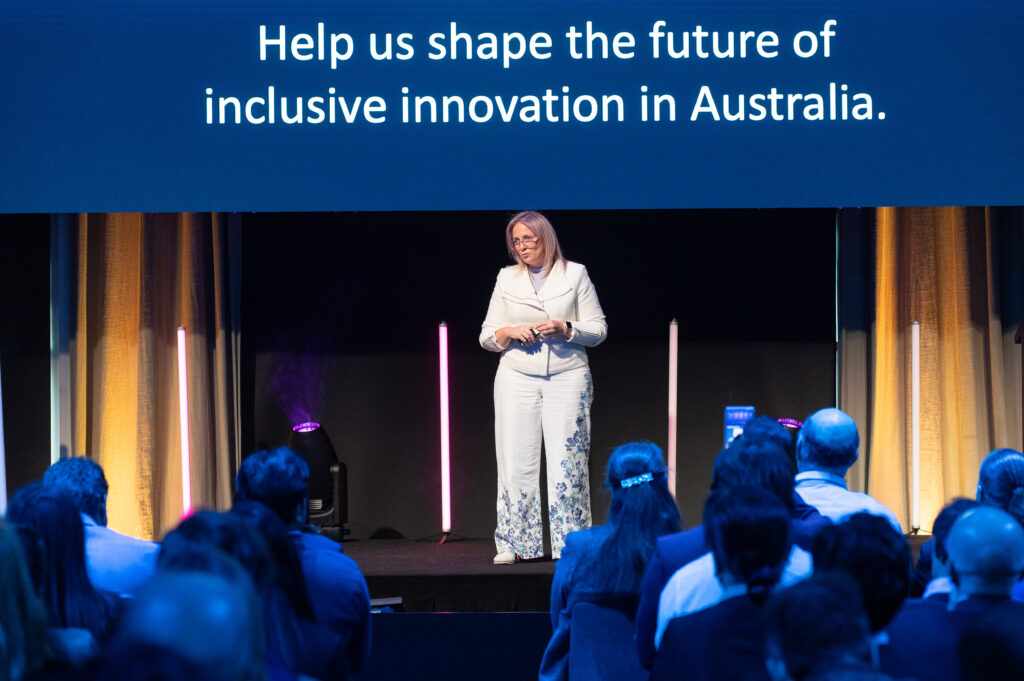Despite decades of progress, Australia’s innovation ecosystem continues to grapple with systemic barriers hindering the full participation of women, First Nations people and other underrepresented groups.
While we’ve moved beyond overt exclusions of the past – like policy requiring married women to resign from their roles in public service until the 1970s – progress continues to remain elusive. We must cultivate ecosystems that genuinely support individuals in unlocking their full potential, dismantle structural inequalities and genuinely help Australia adapt to evolving challenges.
One of the most persistent myths hindering diversity in innovation is the belief that there “aren’t enough” talented individuals from diverse backgrounds, yet the data tells a different story. Women constitute over one-third of new business founders in Australia; and represent nearly half of the academic population.
The problem isn’t a scarcity of talent – it’s the lack of inclusive systems.

The door to inclusivity isn’t closed, but it is certainly stuck
Women researchers are predominantly found in social sciences and humanities , fields with significant impact and economic growth potential, yet they remain widely overlooked in research commercialisation opportunities.
The innovation ecosystem often celebrates a limited view of success, often epitomised by tech startups aiming for ‘unicorn’ status. This narrow focus appeals to certain groups more than others and fails to capture the full spectrum of innovation driving Australia’s GDP and economic forecasts.
Female-dominated professional services, including health and social assistance sectors, are some of Australia’s largest and fastest-growing industries, and are pivotal for economic growth. Yet these sectors are not recognised or treated with the same innovation potential when compared to SaaS, AI, machine learning, fintech and advanced manufacturing – for example.

To engage diverse groups effectively, different practices are necessary
When looking at the motivators behind research translation, the goals of researchers and entrepreneurs from diverse backgrounds can be vastly different, often with a strong focus on community and social impact over financial returns.
There’s a strong correlation between women and First Nations researchers and projects addressing community needs, policy, and practical solutions to real-world challenges. Research shows women entrepreneurs are more likely to make both more pro-social and pro-environmental decisions in conducting business; two aspects we could desperately use more of in the innovation sector.
The Techstars Sydney Central 2024 cohort reinforces this, featuring a high proportion of women founders and strong social and community impact. Deliberate steps were taken to ensure the cohort appealed beyond the usual demographics. Similarly, the Young Indigenous Women’s STEM Academy empowers young Indigenous women to pursue STEM careers, providing tailored support from high school through tertiary education and employment.
These programs have made distinct decisions to increase their innovation potential, recognising that if you genuinely want to see different results, you genuinely must take different approaches – approaches often in stark contrast to many programs designed to support Australia’s next wave of ‘unicorns’.
Limiting our innovation potential – the real cost of exclusion
Differences in research translation motivations do not imply that researchers from diverse backgrounds do not wish to achieve the same financial and business success though. Rather, the ecosystem is failing to tap into diverse drivers and understand diverse circumstances that enables the translation of research into applications. In practice, this reinforces barriers to engagement.
Expectations like excessively long workdays are incompatible with the realities of most people’s lives, especially those with caring responsibilities. Women continue to spend roughly double the time on unpaid care work; yet are expected to conform to workplace models that ignore these responsibilities.
Beyond these expectations, the funding landscape remains starkly unequal. Women-founded companies receive a mere fraction of investment compared to all-male teams — approximately $1 million versus $3.2 million, with total funding dropping from two to three per cent in 2024. These statistics aren’t just unfair, they’re economically shortsighted. By not funding and excluding diverse innovators, we’re limiting our potential.
Women and First Nations researchers are making rational assessments of the innovation ecosystem’s capacity to support their research translation journey. Seeing researchers like themselves struggling for resources, support, and investment – or failing to see them at all – results in disengagement from traditional incubators and accelerators.
Lack of representation has a direct impact on Australia’s long-term innovation pipeline. Applications to accelerator programs by women and people from diverse backgrounds remain low, yet when they are advanced, the quality and competitiveness is often far beyond baseline requirements.
Why is this the case? Because having already overcome multiple barriers to their participation, these researchers have often spent more time extensively refining the quality of their ideas and innovations before even starting.
As an industry, we must work harder to move people of diverse backgrounds through to the next stage of programs, increasing representation and improving our chances of a truly prosperous and representative innovation ecosystem.

Getting the fundamentals right is the key to representation, but it’s also just the start
Seeing relatable role models achieve success, secure funding, and receive professional recognition is vital. Research shows that the most impactful role models are those within reach, not distant figures. Witnessing someone like oneself succeed creates a powerful sense of possibility, so how can we create genuine opportunities?
The answers seem overly simple, but that’s the right place to start. For instance:
- Flexible and representative program designs that accommodate diverse needs
- Inclusive language, imagery and communications around innovation and commercialisation
- Adopting ‘universal design’ principles, supporting neurodiversity and disability
- Harassment-free environments and positive organisational cultures
- Supportive structures (timing, facilities, etc.) for individuals with caregiving responsibilities
- Intellectual property frameworks that respect Indigenous knowledge protocols and IP
These ideas are achievable but require genuine allyship and commitment from those currently in positions of privilege to bring every voice into the room. Advancing diversity cannot be the sole responsibility of marginalised groups. We need a collective approach that recognises diversity not as a compliance checkbox but as a fundamental driver of innovation and societal progress.
While we’ve made significant strides in recent decades, complacency is our greatest risk. The moment we believe we’ve “solved” diversity is precisely when we begin to undermine true equality.
Our challenge is clear: Create an innovation ecosystem that doesn’t just welcome diversity but actively cultivates it.
The future of Australian innovation requires deep consideration of the future society we want to live in. We’re at a turning point, with the past few years showing what’s possible when researchers from each corner of society are given access to the right resources and opportunities.
But this progress is fragile, and must be nurtured through sustained funding, ecosystem collaboration and a shared commitment to meaningful change. We know what inequality can produce, generating greater social instability and myriad socio-economic challenges.
It’s not how we want to progress as a nation or as an industry. The future of Australian innovation depends on our willingness to challenge existing systems and embrace diversity of thought, purpose and lived experience required to drive innovation.
Perhaps more than ever Australia needs an ecosystem where every individual, regardless of background, has a genuine opportunity to contribute, innovate, and thrive.
CSIRO’s ON Innovation Program, ANU’s Global Institute for Women’s Leadership and the Wiyi Yani U Thangani Institute for First Nations Gender Justice have partnered to explore how we can create a more inclusive, equitable, and impactful innovation ecosystem in Australia.
In October, a Playbook and a Roadmap for inclusive innovation will be launched supporting the sector in these goals.

